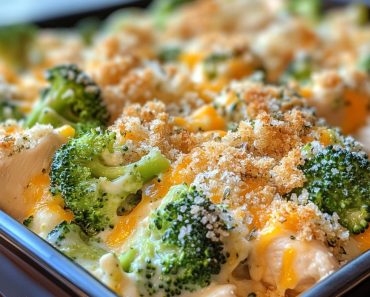
Shrimp Scampi with Garlic Butter Pasta: A Blissful Culinary Escape
Shrimp Scampi with Garlic Butter Pasta is more than just a dish; it’s an experience that combines the comforting warmth of garlic butter, the briny sweetness of shrimp, and the gentle richness of pasta. The moment you pull this recipe together, you’ll realize that it’s perfect for a cozy weeknight dinner or even a romantic evening in. Its delicate yet bold flavors come together effortlessly, and with just a handful of ingredients, you’ll feel like a gourmet chef. Whether you’re an experienced cook or just starting out, this recipe is sure to bring joy to your table and hearts.
Ingredients Overview
- Shrimp (1 pound) – These tender, sweet morsels are the star of the dish. Opt for large, peeled, and deveined shrimp for the best texture. You can also use frozen shrimp; just make sure to thaw them properly before cooking.
- Linguine Pasta (8 oz) – Linguine is the ideal pasta for this dish, with its long, thin shape that elegantly wraps around the garlic butter sauce. If you prefer, you could substitute it with spaghetti or fettuccine for a slight variation.
- Garlic (4 cloves, minced) – The garlic is the soul of the scampi. Fresh garlic adds a wonderful aroma, transforming the butter into an irresistible sauce. Be sure to mince it finely to ensure it cooks quickly without burning.
- White Wine (1/2 cup) – A good dry white wine adds acidity and depth to the dish, complementing the richness of the butter and shrimp. Choose a wine you would enjoy drinking, such as Sauvignon Blanc or Chardonnay.
- Fresh Parsley (1/4 cup, chopped) – A sprinkle of fresh parsley brightens the dish with a pop of color and adds a fresh, slightly peppery note to balance the richness of the garlic butter.
- Butter (4 tbsp) – The key to a luxurious, velvety sauce. Use unsalted butter for more control over the seasoning.
- Salt and Pepper – These simple seasonings elevate the dish. Be sure to taste and adjust to your preference.
- Red Pepper Flakes (optional) – For those who like a little heat, red pepper flakes are a perfect addition. They provide a gentle kick without overpowering the delicate flavors of the shrimp.
Step-by-Step Cooking Instructions
Step 1: Cook the Pasta
Begin by bringing a large pot of salted water to a boil. Add your linguine pasta and cook according to the package instructions until al dente—firm to the bite but not too soft. Once done, drain the pasta and set it aside, reserving about 1/2 cup of pasta water for later use.
Step 2: Sauté the Garlic
In a large skillet, melt the butter over medium heat. As the butter begins to bubble and froth, add the minced garlic. Stir it gently and cook for 1–2 minutes until the garlic becomes fragrant. Be careful not to let it brown, as it can turn bitter.
Step 3: Cook the Shrimp
Add the shrimp to the skillet in a single layer, cooking them for 2–3 minutes per side. The shrimp should turn pink and opaque, indicating they are perfectly cooked. Remove the shrimp from the skillet and set aside.
Step 4: Deglaze the Pan
Pour the white wine into the skillet, scraping the bottom of the pan with a wooden spoon to release any tasty bits that may have stuck. Let the wine simmer for about 1 minute, allowing the alcohol to cook off and the sauce to reduce slightly.
Step 5: Combine the Pasta and Shrimp
Return the shrimp to the skillet, followed by the cooked pasta. Toss everything together, ensuring the pasta is fully coated with the rich garlic butter sauce. If needed, add some reserved pasta water to help thin the sauce to your desired consistency.
Step 6: Final Touches
Season with salt, pepper, and red pepper flakes (if using) to taste. Give everything one last toss, and then sprinkle the chopped parsley over the dish to add a burst of freshness. Serve immediately while the dish is warm and fragrant.
Tips for a Seamless Cooking Experience
- Tip #1: Perfect Pasta Cooking – Make sure to cook your pasta just until al dente to avoid it becoming mushy when mixed with the sauce. Taste a strand of pasta a minute before the time indicated on the package to ensure it’s cooked perfectly.
- Tip #2: Shrimp Prep – If you’re using frozen shrimp, be sure to thaw them thoroughly before cooking. Pat them dry to prevent excess water from interfering with the garlic butter sauce.
- Tip #3: Wine Selection – Choose a dry white wine, like Sauvignon Blanc or Pinot Grigio, as it balances the richness of the butter without overwhelming the dish.
- Tip #4: Don’t Overcook the Shrimp – Shrimp cooks quickly, so avoid overcooking by watching for their color to turn pink and the flesh to become opaque.
- Tip #5: Freshness is Key – Use fresh parsley and freshly minced garlic to maximize the dish’s flavor profile. Fresh ingredients elevate the overall taste!
Storage and Reheating Tips
- Storage – Leftover shrimp scampi can be stored in an airtight container in the refrigerator for up to 2 days. Make sure to let it cool completely before storing to maintain its quality.
- Reheating – To reheat, place the shrimp scampi in a skillet over medium heat. Add a tablespoon of butter or a splash of white wine to help loosen the sauce. Stir occasionally until heated through. You can also reheat it in the microwave, though the stovetop method will help retain the dish’s rich texture better.
Frequently Asked Questions
1. Can I use frozen shrimp for this recipe?
Yes! Just be sure to thaw and dry them properly before cooking.
2. Can I substitute linguine with another type of pasta?
Absolutely! Spaghetti, fettuccine, or even penne will work just fine.
3. What wine should I use for shrimp scampi?
A dry white wine such as Sauvignon Blanc, Chardonnay, or Pinot Grigio is ideal for deglazing and adding flavor.
4. Can I make this recipe without wine?
Yes, you can substitute the wine with chicken broth or vegetable broth if you prefer a non-alcoholic version.
5. How do I know when the shrimp are done cooking?
Shrimp turn pink and opaque when cooked through. They should also curl into a “C” shape, indicating they are tender and perfectly cooked.
6. Can I make this dish ahead of time?
It’s best to make shrimp scampi fresh, but you can prepare the garlic butter sauce ahead and store it in the fridge. Add the shrimp and pasta just before serving.
7. What can I serve with shrimp scampi?
A fresh side salad, crusty bread, or steamed vegetables like asparagus or green beans complement this dish beautifully.
8. Can I add vegetables to the scampi?
Yes, vegetables like spinach, tomatoes, or zucchini can be added to the skillet after the shrimp is cooked.
9. Can I make this recipe dairy-free?
You can use dairy-free butter as a substitute for regular butter in this recipe to make it dairy-free.
10. How spicy is this dish with red pepper flakes?
The dish will have a mild heat with red pepper flakes, but you can adjust the amount to your personal preference or omit them entirely.
11. How can I make the sauce thicker?
If you prefer a thicker sauce, try adding a little more butter or a tablespoon of heavy cream at the end of cooking.
12. Is this recipe good for meal prepping?
While fresh is best, this dish can be prepped and stored in the fridge for up to 2 days. Just remember to reheat gently.
13. Can I use garlic powder instead of fresh garlic?
Fresh garlic provides the best flavor for this dish, but if you must, you can substitute with garlic powder—just 1/2 teaspoon should be enough.
14. Can I use other seafood?
Yes! You can substitute shrimp with scallops or even lobster tail for a luxurious twist.
15. Can I skip the parsley?
While parsley adds freshness, you can skip it if you prefer. You could also use basil or cilantro as an alternative.
16. How do I keep the shrimp tender?
Don’t overcook the shrimp—keep an eye on their color and texture. They cook very quickly, and just a few minutes on each side will be enough.
17. Can I add cheese to shrimp scampi?
While cheese is not traditionally added to shrimp scampi, a sprinkle of Parmesan or Pecorino Romano can complement the dish if desired.
18. How can I make this recipe spicier?
To increase the spice level, use more red pepper flakes, or add a dash of hot sauce to the sauce.
19. Can I double the recipe?
Yes, simply double all the ingredients to make a larger batch, but be sure your skillet is large enough to accommodate it.
20. Is shrimp scampi gluten-free?
If you use gluten-free pasta, this dish can easily be made gluten-free.
20 Secrets to Culinary Perfection with Shrimp Scampi
- Use fresh garlic for maximum flavor.
- Avoid overcooking shrimp—perfectly cooked shrimp are tender and juicy.
- Reserve some pasta water for thinning the sauce if needed.
- Simmer the wine long enough to cook off the alcohol and concentrate its flavor.
- Use unsalted butter for more control over the salt content.
- Make sure the pasta is al dente to maintain the best texture.
- Add a squeeze of fresh lemon juice at the end for an extra layer of freshness.
- Don’t skip the parsley—it’s essential for color and balance.
- For a more robust flavor, use a mix of white wine and a little bit of chicken broth.
- If you like your scampi extra creamy, add a splash of heavy cream.
- Shrimp scampi pairs wonderfully with a crisp white wine—enjoy both while cooking!
- Don’t overcrowd the shrimp in the skillet; cook them in batches if necessary.
- Use a high-quality olive oil in combination with butter for the best base.
- Toss the pasta in the sauce gently to ensure even coverage.
- Opt for freshly chopped parsley over dried parsley for maximum flavor.
- Add a handful of cherry tomatoes for a pop of color and sweetness.
- If you’re a fan of heat, try adding diced fresh chili peppers alongside the garlic.
- Pair the dish with a light salad for a well-rounded meal.
- Toast some garlic bread to serve alongside the shrimp scampi for extra indulgence.
- Finish the dish with a sprinkle of freshly cracked black pepper for added flavor depth.
With these tips and the serene magic of shrimp scampi, your culinary adventure will not only delight your taste buds but also soothe your soul




















